
SculptureCenter, New York
23 September – 11 December 2023
by ELIZABETH BUHE
Tania Pérez Córdova conceives of sculpture as an event, so the sliding scales of its duration encompass its making, the histories of its materials, and any future activations while exhibited. Each of four concrete blocks in All Our Explanations (2022), for instance, consists of a face in negative relief sourced from anonymous 3D models, filled with ice that melts slowly on to the plinth below.
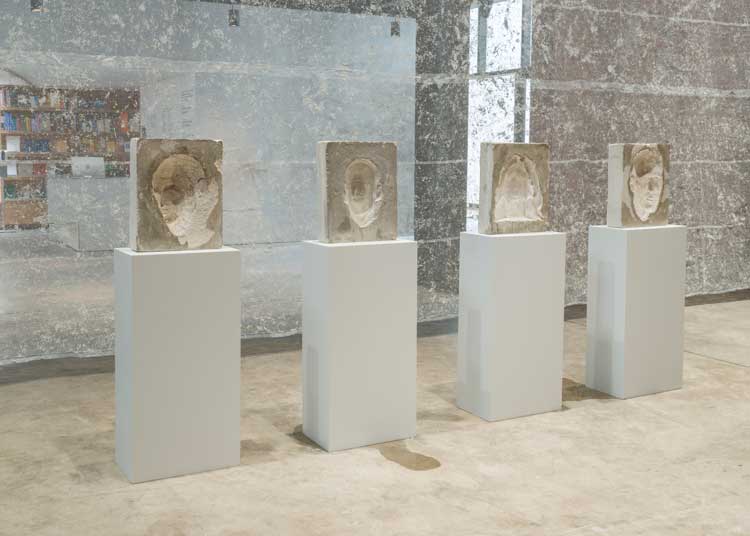
Tania Pérez Córdova, All Our Explanations (Todas nuestras explicaciones), 2022. Concrete, melting ice, carbon steel, various materials, dimensions variable. Installation view, Tania Pérez Córdova: Generalization, SculptureCenter, New York, 2023. Commissioned by Museo Tamayo, Mexico City. Courtesy the artist. Photo: Charles Benton.
Multiple timeframes, or lifetimes, are implied here: the person whose face becomes increasingly visible over time; the ice itself; the concrete block, which degrades slowly with each melt; and the museum staff who tend to the work’s trickling trails of water. (“Mop as needed,” is one of the three routines for this work listed in the exhibition pamphlet.) Thus, the artist sets in motion the human tendency to imagine further narratives on each count. These narratives are situated within and beyond the museum’s walls, and they are guided by what we may or may not know about the materialities, personal circumstances, or institutional systems a work engages. Such proliferating speculation exists only in viewers’ minds. It seems like part of the work, too.
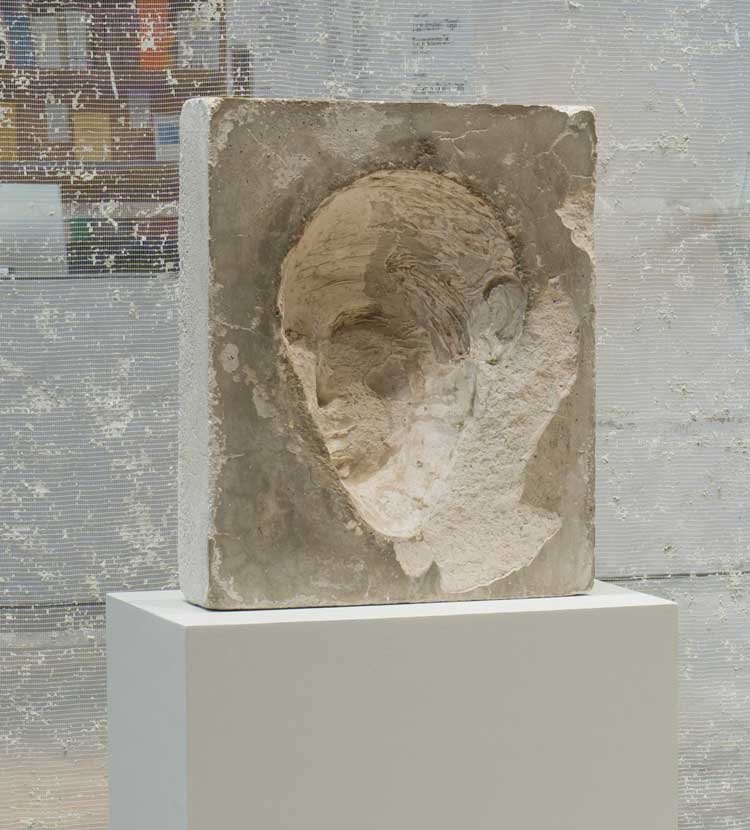
Tania Pérez Córdova, All Our Explanations (Todas nuestras explicaciones), 2022 (detail). Concrete, melting ice, carbon steel, various materials, dimensions variable. Installation view, Tania Pérez Córdova: Generalization, SculptureCenter, New York, 2023. Commissioned by Museo Tamayo, Mexico City. Courtesy the artist. Photo: Charles Benton.
At the artist’s first survey in the US, Generalization, at SculptureCenter in Queens, it is not immediately apparent what is sculpture, what is museum infrastructure and what is a choreographed event in the midst of unfolding. Throughout, Pérez Córdova draws on performance art’s explosion of duration, minimalism’s outsourcing of fabrication and emphasis on encounter, and conceptualism’s unearthing of buried truths. But unlike the forensics of conceptual art from the 1970s, Pérez Córdova’s truths are not so sure. If anything, the works throw us back into loops of uncertainty and wonder.
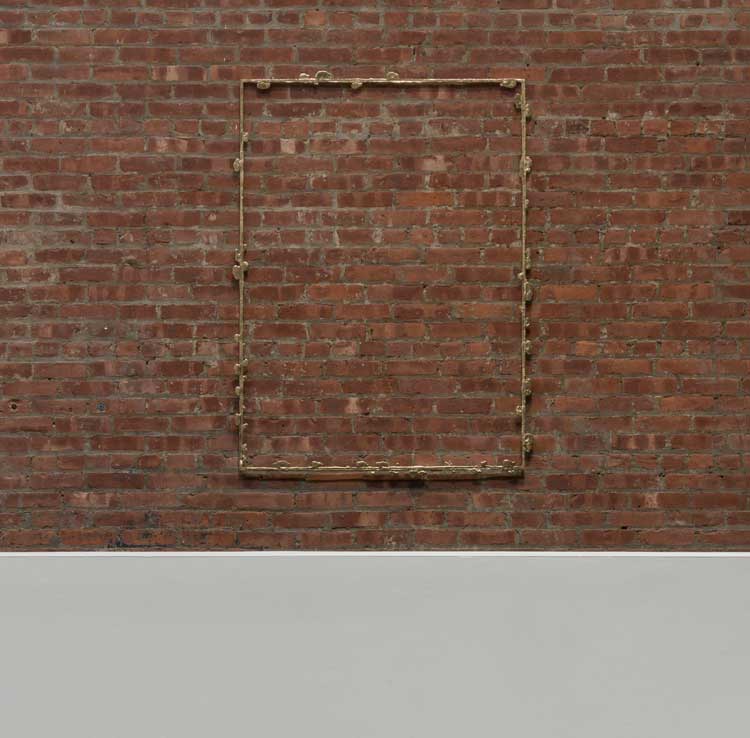
Tania Pérez Córdova: Generalization, installation view, SculptureCenter, New York, 2023. Courtesy the artist. Photo: Charles Benton.
Delicately beautiful gleaming gold window frames (View to a Square from a City That Was Once a Capital, 2022) hang on the wall like ghostly sentinels to a past whose view –once a vista or an interior – is occluded figuratively and literally. What it frames is now the blank wall of the institution (and its histories, including whatever may have hung in that spot before.) What became of the original window’s site? Was the work cast from measurements, or from the slippery precision of memory? While Pérez Córdova does not present fiction as fact, as did the parafictional practices of recent decades, the works often yield similar effects. Among them: curiosity, the ability to change our minds, and – perhaps most timely, considering what is unfolding in global politics, in the blossoming of AI, and in Gaza as I write – sitting with uncertainty.
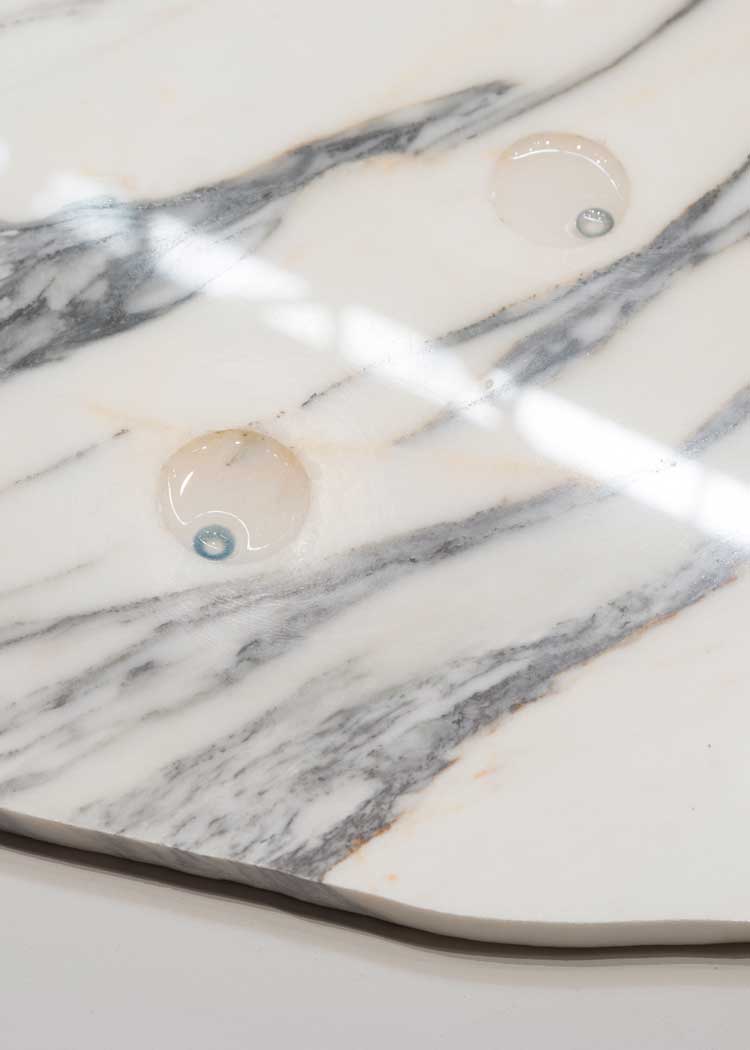
Tania Pérez Córdova, You, Me, Us, You, Them (Tu, yo, nosotrxs, ustedes, ellxs), 2022 (detail). Marble, personalized cosmetic contact lenses, one or more people wearing contact lenses of a colour different from their natural eyes. 1 x 64 x 69 in (2.5 x 163 x 175 cm). Installation view, Tania Pérez Córdova: Generalization, SculptureCenter, New York, 2023. Commissioned by Museo Tamayo, Mexico City. Courtesy the artist and Galerie Art: Concept, Paris. Photo: Charles Benton.
Pérez Córdova was born in Mexico in 1979, and this show is presented by curator Humberto Moro as a mini retrospective. Most works are dispersed throughout the vast central gallery at SculptureCenter, a former trolley building near Long Island City’s main transit hub, so there is no apparent chronology to follow. Still, in about 2022 there is a shift from works that present situations of duality to those that are more rhizomatic. The duality of earlier works might arise from the positive/negative or original/copy logic of casting, for example, or from the preference that a performative element relate back to its sculptural counterpart so that half the work is a material certainty and the other isn’t. I am thinking of the large navy vase (Portrait of an Unknown Person Passing By, 2019) glazed with cascading gingko leaves, which may or may not be accompanied by a woman in a matching dress walking through the galleries, or the contact lenses floating in saline solution atop a white marble slab (You, Me, Us, You, Them, 2022), which may or may not be accompanied by people in the museum wearing a solitary lens that pairs with one from the table. Pérez Córdova’s signature move of a material here that possibly but not definitely relates to an intermittent, simultaneous there disrupts our comfort with quotidian scales of time and what constitutes an object. The term objecthood is apropos here, because it suggests spatial continuity with the surrounding world.
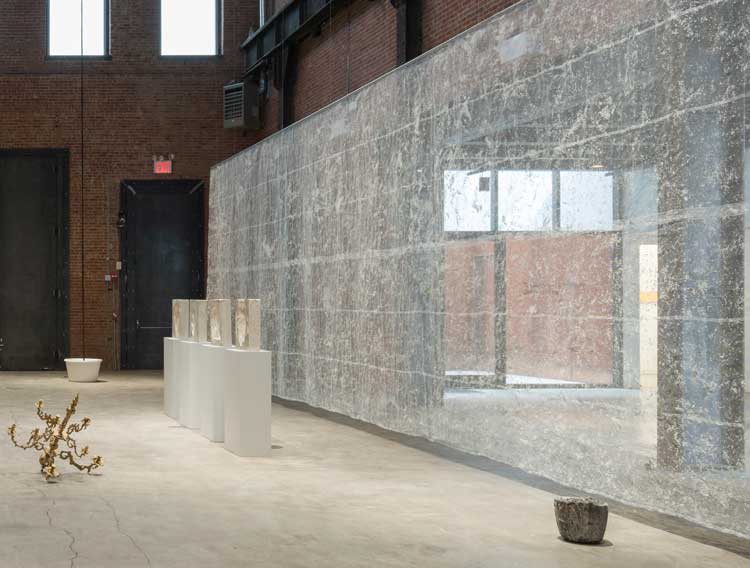
Tania Pérez Córdova. Name, Phone, Email, Postcode, 2023. Installation view, SculptureCenter, New York, 2023. Courtesy the artist. Photo: Charles Benton.
More recent works exceed this conceptual structure of duality or doubling. These, too, ask us to see the world with different eyes. They also allude to the ethics of how we assign value to objects, to others, and to ideology. Name, Phone, Email, Postcode (2023) is a massive diaphanous veil hung from the ceiling that SculptureCenter commissioned for this show, which runs the length of the gallery. Made with paper pulp from industrially shredded private documents that Pérez Córdova purchased, the work limns the boundary of the extremely personal and the inevitably generalised, that moment when one type of value is evacuated and then suddenly accrues usefulness in another way. As one of the first works we see, it establishes the conceptual rigour of Pérez Córdova’s practice. Her work is a conceptual index of all those invisible systems that structure our every move, regulating time, assigning value, sharpening those distinctions we buy into about what differentiates “us” from “them”.
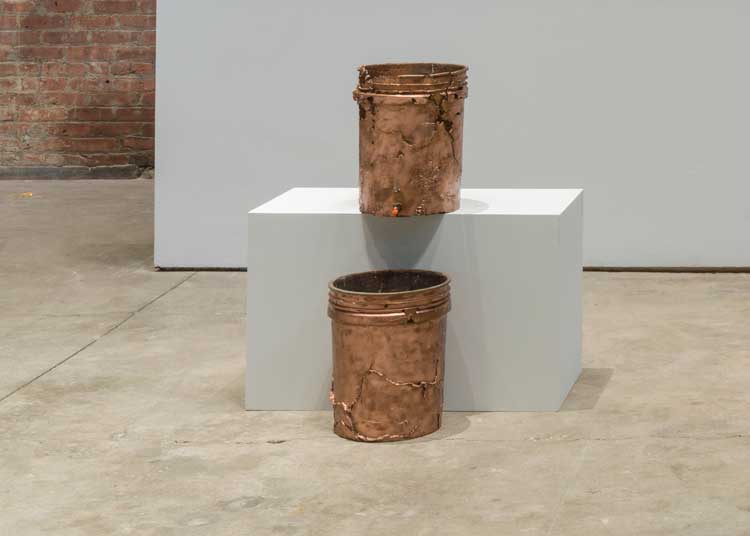
Tania Pérez Córdova, A Speech of 5,200 Words (Un discurso de 5200 palabras), 2022. Copper and 5,200 drops of artificial saliva, dimensions variable. Commissioned by Museo Tamayo, Mexico City. Courtesy the artist and Tina Kim Gallery, New York. Photo: Charles Benton.
Also relevant in this vein is A Speech of 5,200 Words (2022), a cracked copper construction bucket filled with artificial saliva that sits on a low plinth. A spigot affixed near its bottom edge emits a slow drip into a second bucket below. The title points to the increasing length of political speeches over time, with the 5,200 drops of saliva contained in the buckets keyed to the likewise increased volume of saliva needed to perform them. Left to wonder how spit takes shape as words, we also ask: when do we believe what we see? Hear? What counts as proof? Like Pérez Córdova’s casts of ordinary objects – the buckets in this work, a chandelier, a Dutch oven – made by melting down the original and remaking it in a cast of its former self, the transfer of saliva from one bucket to the other is a lossy process. Metal is displaced, liquid evaporates. Yet far from the diminishing worth of cracked, holey, or incomplete objects, the permutations of ideological statements repeated across social media accrues in amplitude. Concretised in a single object, Pérez Córdova pinpoints competing systems of value – moral, ideological, monetary, the politics of labour – that are ephemeral until materialised outside the aesthetic sphere, as a vote, a pay cheque, a purchase.
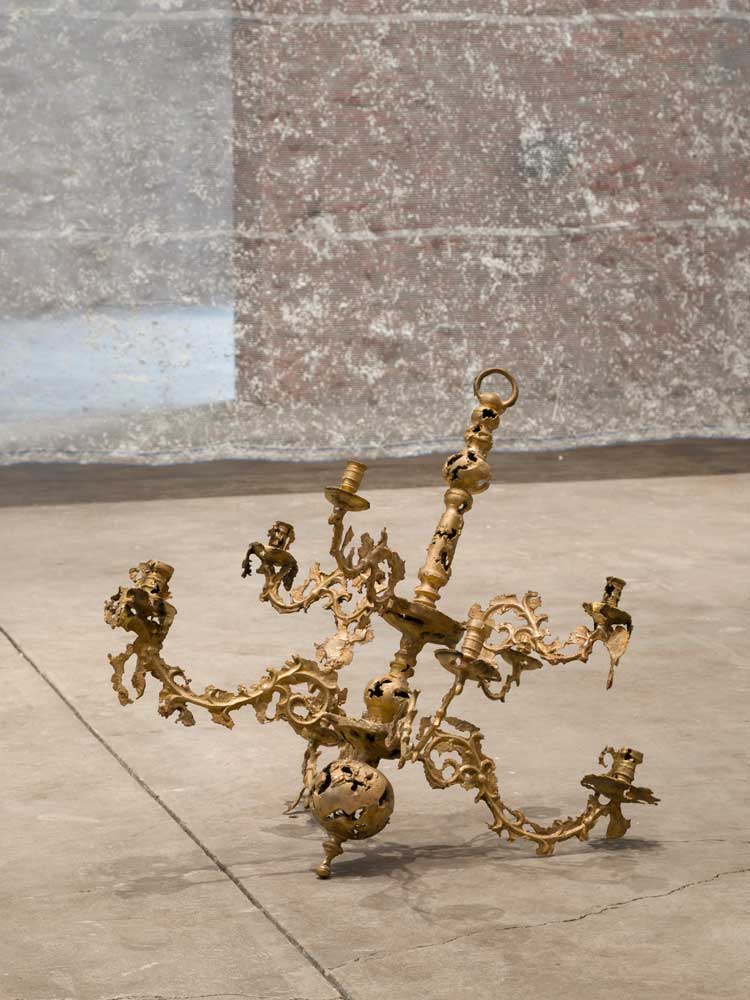
Tania Pérez Córdova, A Chandelier Into a Chandelier (Un candelabro en un candelabro), 2023. Brass chandelier that was cast, melted, and recast into its own mold, 33 x 34 x 34 in (84 x 86 x 86 cm). Installation view, Tania Pérez Córdova: Generalization, SculptureCenter, New York, 2023. Commissioned by SculptureCenter, New York. Courtesy the artist and Tina Kim Gallery, New York. Photo: Charles Benton.
In interviews, Pérez Córdova often speaks of her encounters with fabricators, such as watching Italian workers struggling to laminate glass without getting dust stuck in it. Such episodes might give the artist an idea for a work, transmuted into a different form. But they also foreground the intersubjective nature of her making: learning how to do it, collaborating with others, and pushing experts beyond their comfort zone to allow for the fabrication of something that is not conventionally acceptable. That this appreciation for craft centres on labour is evident in a small work, Strike (2018), tucked on a back wall. In it, two extinguished cigarette butts protrude from a hardened loaf of bread. The context is both specific in its allusion to Italian baker strikes and shared across time and place. As Pérez Córdova’s architectural frames and contact lenses suggest, how we perceive it depends on how we choose to see.
This elegantly composed exhibition celebrates 25 years’ of awards to female artists by Anonymous W...
The first of its kind, this vast show is a stunning tour of the realism movement of the 1920s and 30...
Maggi Hambling: ‘The sea is sort of inside me now … [and] it’s as if...
Maggi Hambling’s new and highly personal installation, Time, in memory of her longtime partner, To...
Caspar Heinemann takes us on a deep, dark emotional dive with his nihilistic installation that refer...
Complex, multilayered paintings and sculptures reek of the dark histories of slavery and colonialism...
Shown in the context of the historic paintings of Dulwich Picture Gallery, Rachel Jones’s new pain...
William Mackrell – interview: ‘I have an interest in dissecting the my...
William Mackrell's work has included lighting 1,000 candles and getting two horses to pull a car. No...
Marina Tabassum – interview: ‘Architecture is my life and my lifestyle...
The award-winning Bangladeshi architect behind this year’s Serpentine Pavilion on why she has shun...
A cabinet of curiosities – inside the new V&A East Storehouse
Diller Scofidio + Renfro has turned the 2012 Olympics broadcasting centre into a sparkling repositor...
Plásmata 3: We’ve met before, haven’t we?
This nocturnal exhibition organised by the Onassis Foundation’s cultural platform transforms a pub...
Ruth Asawa: Retrospective / Wayne Thiebaud: Art Comes from Art / Walt Disn...
Three well-attended museum exhibitions in San Francisco flag a subtle shift from the current drumbea...
This dazzling exhibition on the centenary of John Singer Sargent’s death celebrates his versatile ...
Through film, sound and dance, Emma Critchley’s continuing investigative project takes audiences o...
Rijksakademie Open Studios: Nora Aurrekoetxea, AYO and Eniwaye Oluwaseyi
At the Rijksakademie’s annual Open Studios event during Amsterdam Art Week, we spoke to three arti...
AYO – interview: Rijksakademie Open Studios
AYO reflects on her upbringing and ancestry in Uganda from her current position as a resident of the...
Eniwaye Oluwaseyi – interview: Rijksakademie Open Studios
Eniwaye Oluwaseyi paints figures, including himself, friends and members of his family, within compo...
Nora Aurrekoetxea – interview: Rijksakademie Open Studios
Nora Aurrekoetxea focuses on her home in Amsterdam, disorienting domestic architecture to ask us to ...
Kiki Smith – interview: ‘Artists are always trying to reveal themselve...
Known for her tapestries, body parts and folkloric motifs, Kiki Smith talks about meaning, process, ...
Frank Auerbach, Britain’s greatest postwar painter, has a belated German homecoming, which capture...
How Painting Happens (and why it matters) – book review
Martin Gayford’s engrossing book is a goldmine of quotes, anecdotes and insights, from why Van Gog...
Jonathan Baldock – interview: ‘Weird is a word that’s often used to...
As a Noah’s ark of his non-binary stuffed toys goes on show at Jupiter Artland, Jonathan Baldock t...
Helen Chadwick: Life Pleasures
Helen Chadwick’s unwillingness to accept any binary division of the world allowed her to radically...
Catharsis: A Grief Drawn Out – book review
To what extent can the visual language of grief be translated? Janet McKenzie looks back over 20 yea...
Radical Software: Women, Art & Computing 1960-1991
With more than 100 works by 50 artists, this show examines the pioneering role of women in computer ...
Dame Jillian Sackler, the art lover and philanthropist, has died aged 84...
Giuseppe Penone: Thoughts in the Roots
With numerous works created with the twigs, leaves, roots, branches and majestic forms of trees, thi...
Solange Pessoa: Pilgrim Fields
An olfactory orgy of marigolds, chamomile, grasses, sheepskins and kelp is arranged into a surreal l...
Christian Krohg: The People of the North
A key figure in Norwegian art, naturalist painter Christian Krohg wanted his art to bring social cha...
This comprehensive show charts the groundbreaking rise of the illustrated poster in 19th-century Fra...
Caspar David Friedrich: The Soul of Nature
This comprehensive show celebrating last year’s 250th anniversary of the Romantic painter’s birt...